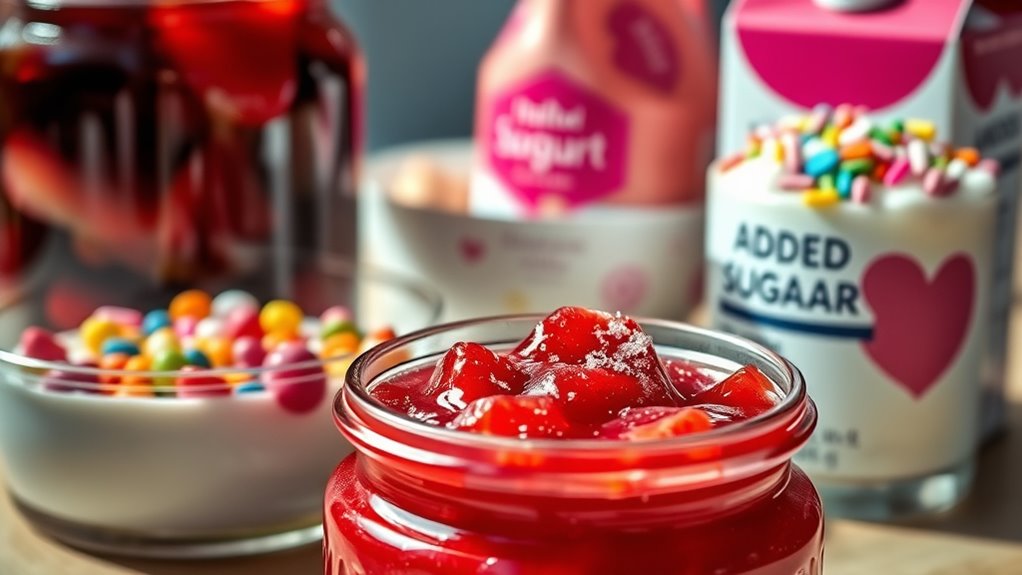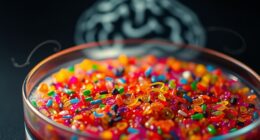Hidden sugars are present in many common foods like condiments, cereals, bread, flavored yogurt, granola bars, and savory snacks, often disguised by ingredients such as maltodextrin, dextrose, honey, or fruit juice concentrate. These sneaky sugars can spike your blood sugar and lead to cravings, making it harder to stick to healthy habits. Recognizing these foods and understanding how they influence your brain can help you make smarter choices. Keep exploring to discover more ways to beat hidden sugars.
Key Takeaways
- Condiments like ketchup and salad dressings often contain hidden sugars, contributing to excess intake without obvious awareness.
- Packaged cereals and flavored yogurt are common sources of added sugars disguised as natural ingredients.
- Bread and savory snacks may include ingredients like maltodextrin and dextrose, increasing sugar content unexpectedly.
- Granola bars and snack bars frequently contain added sugars or natural sweeteners that spike blood sugar levels.
- Beverages such as flavored teas and smoothies can hide significant amounts of sugar, sabotaging diet goals.

Many processed foods contain hidden sugars that can secretly increase your daily intake without you realizing it. These sneaky ingredients are everywhere—condiments, cereals, bread, and even savory snacks. What makes this especially tricky is that manufacturers often replace traditional sugar with alternative sweeteners or add natural sweeteners like honey or agave syrup, which are marketed as healthier options. While natural sweeteners may seem like a better choice, they still contribute to your overall sugar consumption and can keep your taste buds craving more. Over time, consuming these hidden sugars can lead to sugar addiction, making it harder to enjoy foods without that sweet kick.
Hidden sugars in processed foods can secretly boost your intake and fuel cravings over time.
When you regularly consume foods packed with hidden sugars, your brain starts to associate sweetness with comfort, which can lead to increased cravings and overeating. This cycle keeps you hooked, even if you’re trying to cut back. Many people don’t realize that a seemingly innocent granola bar or flavored yogurt can pack a hefty dose of sugar, often disguised under different names like maltodextrin, dextrose, or fruit juice concentrate. These ingredients can spike your blood sugar levels and then cause crashes, fueling a cycle of hunger and snacking that sabotages your diet. The more you indulge in these foods, the more your body adapts to craving sweetness, reinforcing the cycle of sugar addiction.
You might think that switching to natural sweeteners is a healthier move, but it’s important to be cautious. While they do contain some nutrients and are less processed than refined sugar, they’re still sources of sugar that can keep your cravings alive. Eating too many foods with natural sweeteners can make it harder to reset your palate and reduce your overall sugar intake. The key is moderation; consuming these alternatives sparingly and focusing on whole, unprocessed foods can help break the cycle. Recognizing how these ingredients impact your neural networks and cravings can empower you to make better dietary choices. Additionally, understanding the brain’s response to sugar can help you develop strategies to reduce dependence and improve your overall health.
Being aware of hidden sugars in your diet is the first step toward reducing your intake. Read labels carefully and look beyond marketing claims that label products as “natural” or “healthy.” Recognize that sugar addiction isn’t just about willpower but also about understanding how these hidden ingredients influence your brain and body. For example, advancements in neural networks in machine learning are helping researchers better understand addiction patterns and develop strategies to combat cravings. These insights reveal how dopamine release reinforces sugar cravings and can be used to create more effective interventions. By cutting back on processed foods and choosing whole foods, you can gradually retrain your palate, lessen your dependence on sugary foods, and regain control over your diet. Ultimately, reducing hidden sugars is about making smarter choices that support your health instead of sabotaging it.
Frequently Asked Questions
Are Natural Sugars Safer Than Added Sugars in Foods?
Natural sugars are generally considered safer than added sugars because they come with fiber, vitamins, and minerals that slow digestion and support healthy sugar metabolism. With natural vs. added sugars, your body processes them differently, often leading to steadier blood sugar levels. While natural sugars are better, it’s still important to consume them in moderation, as excessive intake can still impact your health and sugar metabolism.
How Can I Identify Hidden Sugars on Food Labels Easily?
To identify hidden sugars on food labels, start by reading nutrition labels carefully. Look beyond the “sugar” line and recognize common sugar synonyms like glucose, fructose, corn syrup, and agave nectar. Check the ingredients list for these terms, especially if they appear early. Being vigilant helps you spot added sugars easily and make healthier choices, even when labels aren’t straightforward.
Do Sugar Substitutes Help Reduce Overall Sugar Intake?
Thinking of sugar substitutes as a double-edged sword, you might wonder if they genuinely cut your sugar intake. They can help reduce overall sugar consumption, but their efficacy varies. While many artificial sweeteners are deemed safe, some people worry about long-term effects. Ultimately, using sugar substitutes can be effective if you choose options with proven safety, but they shouldn’t replace a balanced diet. Balance remains key to health.
Which Foods Contain the Highest Hidden Sugar Levels?
You might not realize it, but some foods contain high hidden sugar levels. Fruit snacks and flavored yogurts are prime examples, often packed with added sugars to enhance taste. Check labels carefully, as these products can spike your sugar intake without you noticing. Avoiding or choosing unsweetened versions helps reduce hidden sugars, making it easier to stick to your diet goals and maintain better overall health.
Can Cutting Out Hidden Sugars Improve My Energy Levels?
Imagine opening a new level of energy—cutting out hidden sugars can do just that. When you start a sugar detox, your blood sugar stabilizes, preventing energy crashes. This natural energy boost keeps you alert and focused. By removing sneaky sugars from your diet, you’re fueling your body more effectively, and the result? Steady, sustained vitality that makes each day feel brighter and more productive.
Conclusion
If you ignore the hidden sugars lurking in everyday foods, you might as well be sabotaging your diet with a wrecking ball! These sneaky sugars can secretly sabotage your weight loss and health goals faster than you can say “hidden calories.” Stay vigilant, read labels carefully, and cut out these sneaky offenders. Otherwise, your efforts could be undone in a heartbeat, leaving you wondering why progress seems impossible. Don’t let hidden sugars win—beat them before they win!










